Author:
Publisher/Journal: online, Electronic Journals of Martial Arts and Sciences
Posted: June 10, 2002
Abstract:
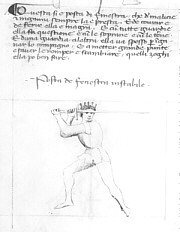 The Principles of Fiore dei Liberi's martial system is based upon the translation of the Getty Collection's MS by Eleonora Litta and Mat Easton and the interpretation of that translation by the Exiles, Company of Medieval Martial Artists. Fiore's manual can be viewed as being a large collection of individual techniques grouped by armoured and not armoured, further subdivided by weapon type. It may, therefore, appear that when looking for the principles of Fiore's system that we need to start from there, however, a close look at the manual will show that between each division there is a brief section that introduces each new part. In these introductions Fiore discusses some of the concepts that are relevant, not only to that section, but also indeed to the whole manual. It is from these concepts that this essay will begin, before moving onto the techniques that make up the larger part of the manual.
The Principles of Fiore dei Liberi's martial system is based upon the translation of the Getty Collection's MS by Eleonora Litta and Mat Easton and the interpretation of that translation by the Exiles, Company of Medieval Martial Artists. Fiore's manual can be viewed as being a large collection of individual techniques grouped by armoured and not armoured, further subdivided by weapon type. It may, therefore, appear that when looking for the principles of Fiore's system that we need to start from there, however, a close look at the manual will show that between each division there is a brief section that introduces each new part. In these introductions Fiore discusses some of the concepts that are relevant, not only to that section, but also indeed to the whole manual. It is from these concepts that this essay will begin, before moving onto the techniques that make up the larger part of the manual. Rob goes on to discuss the four principles which begins with "knowing the opponent" in terms of the opponent's strength, size, age and skill. He delves into details of each of the principles followed by Liberi's "sevn requirements of wrestling". It was felt that wrestling or grappling formed the foundation of fighting, and from which all other fighting styles with or without weapons can be derived.
View article online, courtesy of Mr. Rob Lovett
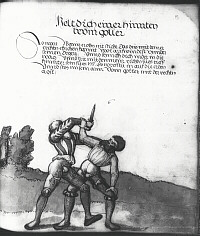 The subject of Historical European Martial Arts (HEMA) has been so far been addressed only marginally both in the literature and in the Western martial arts community. Their traditions disappeared long ago and in contrast to the Eastern martial arts with the sole exception of wrestling, HEMA cannot be reconstructed solely on the basis of any of today's modern combatitive sport. The Fechtschulen and Fechtmeisteren no longer exist, and there are no individuals analogous to the Eastern sensei who could teach students how to fight with a sword, cutlass or halberd. The only reasonable option for HEMA reconstruction is the research and study of Fechtbücher (fighting treatises) and applying the knowledge contained therein in practice.
The subject of Historical European Martial Arts (HEMA) has been so far been addressed only marginally both in the literature and in the Western martial arts community. Their traditions disappeared long ago and in contrast to the Eastern martial arts with the sole exception of wrestling, HEMA cannot be reconstructed solely on the basis of any of today's modern combatitive sport. The Fechtschulen and Fechtmeisteren no longer exist, and there are no individuals analogous to the Eastern sensei who could teach students how to fight with a sword, cutlass or halberd. The only reasonable option for HEMA reconstruction is the research and study of Fechtbücher (fighting treatises) and applying the knowledge contained therein in practice. Much has been written and discussed across the historical European martial arts community in articles and forums on the subject of the value or lack of value of practice cutting employing sharp swords. Often there is great emphasis on the importance of practice cutting with respect to enhancing one's skills with the sword, occasionally with little concern for the foundational training while other opinions regard this exercise as unimportant in the context of overall swordsmanship training. There is also a noticeable absence of specific material on this aspect of training in any of the historical treatises and "fechtbuchs".
Much has been written and discussed across the historical European martial arts community in articles and forums on the subject of the value or lack of value of practice cutting employing sharp swords. Often there is great emphasis on the importance of practice cutting with respect to enhancing one's skills with the sword, occasionally with little concern for the foundational training while other opinions regard this exercise as unimportant in the context of overall swordsmanship training. There is also a noticeable absence of specific material on this aspect of training in any of the historical treatises and "fechtbuchs". There exists a ground swell, and it's called historical European martial arts or HEMA. In both Canada and the United States, an impressive revival of awareness, interest, research and development in HEMA is occurring. Numerous organizations and groups have been created in the last ten years that focus on western fighting techniques from the early medieval period to the late renaissance periods. Collectively, many of these groups and organizations that possess
There exists a ground swell, and it's called historical European martial arts or HEMA. In both Canada and the United States, an impressive revival of awareness, interest, research and development in HEMA is occurring. Numerous organizations and groups have been created in the last ten years that focus on western fighting techniques from the early medieval period to the late renaissance periods. Collectively, many of these groups and organizations that possess 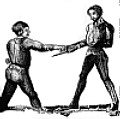 A two part article describing the so-named for the Archive in Solothurn, Switzerland where it was found, this book is believed to be from the 15th century and its author is unknown. It's techniques closely resemble the ones from some of Talhoffer's Fechtbuchs. There are conflicting theories about its origins, with guesses as to the date of publication from 1420-1490, but I believe from the costuming of the people and the technical material it is probably from the 1480's and is in fact a semi-rip-off of Talhoffer.
A two part article describing the so-named for the Archive in Solothurn, Switzerland where it was found, this book is believed to be from the 15th century and its author is unknown. It's techniques closely resemble the ones from some of Talhoffer's Fechtbuchs. There are conflicting theories about its origins, with guesses as to the date of publication from 1420-1490, but I believe from the costuming of the people and the technical material it is probably from the 1480's and is in fact a semi-rip-off of Talhoffer.
 The Quarterstaff was for centuries considered the weapon of the lower sections of society, although the nobility had a healthy respect for the Quarterstaff, which they also practised. In reality Quarterstaffing, as a fighting art reigned supreme in England for many centuries. The English art of Quarterstaffing has throughout the many centuries, gained its own individuality and traditions. Through the dedication of the men and women, who for generations have brought this majestic weapon forward into the 21st century, with the blood sweat and tears of hard practice, and hard knocks.
The Quarterstaff was for centuries considered the weapon of the lower sections of society, although the nobility had a healthy respect for the Quarterstaff, which they also practised. In reality Quarterstaffing, as a fighting art reigned supreme in England for many centuries. The English art of Quarterstaffing has throughout the many centuries, gained its own individuality and traditions. Through the dedication of the men and women, who for generations have brought this majestic weapon forward into the 21st century, with the blood sweat and tears of hard practice, and hard knocks.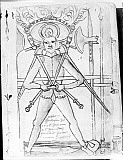 The paper deals with selected aspects of Blossfechten (unarmoured combat) with the longsword as depicted in one of the most renown, yet still
unpublished source of medieval swordsmanship known as Codex Wallerstein (Universitaetsbibliothek Augsburg, I. 6.4°.2). Firstly, the author deals with
the very structure of the manuscripts, proving that it actually consists of two different manuals (the one from late fourteenth-early fifteenth century, the other
from about mid-fifteenth century, which were later put together). Furthermore, the question of the way in which the section under analysis was
accomplished is discussed: it is suggested that the images were put in first, and then provided with relevant comments. Next, the author attempts at
classifying the weapon presented in the section by means of comparing it to a well-known and commonly accepted typology of Robert E. Oakeshott.
Moreover, several remarks concerning the functionality of such particular types of weapon are introduced. Furthermore, the author deals with several
general fighting principles as presented in the manuscript, trying to affiliate them to the school of German swordsmaster Johannes Liechtenauer; however,
he notices several similarities to other fencing manuals, with special regard to that of Fiore dei Liberi. Then, the comments concerning particular plates and
fighting actions presented on them are provided. Next, the author attempts at showing several similarities of the actions presented to those depicted in
other medieval fencing manuals. Finally, conclusions and suggestions for further research (comprising in the first row the necessity of a critical edition of the
manuscript) are provided.
The paper deals with selected aspects of Blossfechten (unarmoured combat) with the longsword as depicted in one of the most renown, yet still
unpublished source of medieval swordsmanship known as Codex Wallerstein (Universitaetsbibliothek Augsburg, I. 6.4°.2). Firstly, the author deals with
the very structure of the manuscripts, proving that it actually consists of two different manuals (the one from late fourteenth-early fifteenth century, the other
from about mid-fifteenth century, which were later put together). Furthermore, the question of the way in which the section under analysis was
accomplished is discussed: it is suggested that the images were put in first, and then provided with relevant comments. Next, the author attempts at
classifying the weapon presented in the section by means of comparing it to a well-known and commonly accepted typology of Robert E. Oakeshott.
Moreover, several remarks concerning the functionality of such particular types of weapon are introduced. Furthermore, the author deals with several
general fighting principles as presented in the manuscript, trying to affiliate them to the school of German swordsmaster Johannes Liechtenauer; however,
he notices several similarities to other fencing manuals, with special regard to that of Fiore dei Liberi. Then, the comments concerning particular plates and
fighting actions presented on them are provided. Next, the author attempts at showing several similarities of the actions presented to those depicted in
other medieval fencing manuals. Finally, conclusions and suggestions for further research (comprising in the first row the necessity of a critical edition of the
manuscript) are provided.  If historians from Karl Marx to Michel Foucault have dealt with conflict between dominant and subordinate groups as a primary theme in their work, it is
arguably because of their European background. The notion of social class, it has oft been noted, is more in the fore of the French or British mind than it
is in the American. After all, one often-admired quality of American society is its supposed "egalitarianism." The United States has had a civil war, but
never a revolt of the plebes.[1] Therefore, to the American-born historian, conflict and competition between social equals would seem to be a more
authentically pressing issue than conflict between social classes.
If historians from Karl Marx to Michel Foucault have dealt with conflict between dominant and subordinate groups as a primary theme in their work, it is
arguably because of their European background. The notion of social class, it has oft been noted, is more in the fore of the French or British mind than it
is in the American. After all, one often-admired quality of American society is its supposed "egalitarianism." The United States has had a civil war, but
never a revolt of the plebes.[1] Therefore, to the American-born historian, conflict and competition between social equals would seem to be a more
authentically pressing issue than conflict between social classes.
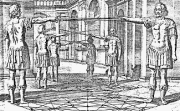 The Spanish School of Swordsmanship, "La Destreza," is the most misunderstood subject in the history of fencing. It has been misrepresented by
fencing scholars for the past one hundred years as an ineffectual and artificial system of swordsmanship full of absurdities. The intent of this article and
others to follow is to present a clearer and more accurate picture of what "La Destreza" is.
The Spanish School of Swordsmanship, "La Destreza," is the most misunderstood subject in the history of fencing. It has been misrepresented by
fencing scholars for the past one hundred years as an ineffectual and artificial system of swordsmanship full of absurdities. The intent of this article and
others to follow is to present a clearer and more accurate picture of what "La Destreza" is.
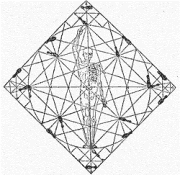 As with most things in the martial arts, the story of fencing is not a simple one. If you ask one
person to tell you what "fencing" is, he might tell you that it's a modern sport. Ask a second, and
she might describe fencing as a five-hundred-year-old martial tradition. Yet a third might mention
Zorro, Cyrano de Bergerac, and other fictional heroes. All of these explanations are, in their own
ways, correct. Therefore, the question becomes which fencing we are speaking of? In his article,
we will seek to tell the story of the Western European tradition of swordsmanship, from its
beginnings to how it is practiced today.
As with most things in the martial arts, the story of fencing is not a simple one. If you ask one
person to tell you what "fencing" is, he might tell you that it's a modern sport. Ask a second, and
she might describe fencing as a five-hundred-year-old martial tradition. Yet a third might mention
Zorro, Cyrano de Bergerac, and other fictional heroes. All of these explanations are, in their own
ways, correct. Therefore, the question becomes which fencing we are speaking of? In his article,
we will seek to tell the story of the Western European tradition of swordsmanship, from its
beginnings to how it is practiced today.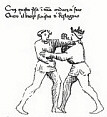 In his 1410 book Flos Duellatorum (The Flower of Battle) Fiore tells us that in his time he met "1000 men who would call themselves masters;
though if their skills were combined, you would not have 4 good students, let alone one True Master", and that he wrote his book at the end of his
life because there was simply no one around who was as skilled as he was, or who knew so many kinds of techniques. If you have studied the
ancient manuals, in my opinion, you will find that he was right. No other manual shows the same amount of clear techniques with such a diversity
of weapons. If you put all of Talhoffer's manuals together, you might get a tome equal to Fiore's, but no single manuscript could claim to be its equal.
In his 1410 book Flos Duellatorum (The Flower of Battle) Fiore tells us that in his time he met "1000 men who would call themselves masters;
though if their skills were combined, you would not have 4 good students, let alone one True Master", and that he wrote his book at the end of his
life because there was simply no one around who was as skilled as he was, or who knew so many kinds of techniques. If you have studied the
ancient manuals, in my opinion, you will find that he was right. No other manual shows the same amount of clear techniques with such a diversity
of weapons. If you put all of Talhoffer's manuals together, you might get a tome equal to Fiore's, but no single manuscript could claim to be its equal.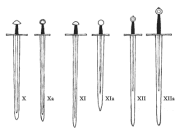 This is an attempt to introduce the reader to Oakeshott's sword blade typology. Ewart Oakeshott is perhaps the most noted
student of swords, and his contribution to our knowledge is significant. In order to make his research easier, he divided the
swords into types. In contrast to other typologies, like Petersen's Viking sword typology that only focuses on the hilt form,
Oakeshott's typology concentrates on the blade and its function. His system makes it easier to date the swords, and coupled
with his classifying of the hilt parts it become rather easy to tell the approximate age of a certain sword. The typology isn't
complete or perfect, something Oakeshott is the first to admit, but it is nonetheless one of the best ways to understand the
development of the medieval sword.
This is an attempt to introduce the reader to Oakeshott's sword blade typology. Ewart Oakeshott is perhaps the most noted
student of swords, and his contribution to our knowledge is significant. In order to make his research easier, he divided the
swords into types. In contrast to other typologies, like Petersen's Viking sword typology that only focuses on the hilt form,
Oakeshott's typology concentrates on the blade and its function. His system makes it easier to date the swords, and coupled
with his classifying of the hilt parts it become rather easy to tell the approximate age of a certain sword. The typology isn't
complete or perfect, something Oakeshott is the first to admit, but it is nonetheless one of the best ways to understand the
development of the medieval sword. wrote this article on the "man" behind Del Tin swords. In Italy, in the foothills of the Alps some 60 miles north of Venice, lies
the town of Maniago. This has been a center of cutlery manufacture
for 400 years, and since 1966 also a prime source for sword replicas.
Del Tin Armi Antiche was started by Silvano Del Tin, father of Fulvio
Del Tin, almost by accident. He was a switchblade maker, who in
1965 made a few swords and halberds for himself. These came to be
on display at an exhibition in Florence, where they became a success.
This made him decide to change his production to replicas of antique
weapons the year after, assisted by his older son Flavio. The other
two sons joined a few years later; Fulvio in 1970, Maurizio in 1973.
Silvano Del Tin passed away in 1975, leaving the company to his
sons. In 1977, Del Tin Armi Antiche relocated to the current
workshop. For many years, Fulvio and his two brothers worked there, but in 1978 Flavio left to become an antiques dealer,
and Maurizio left in 1992. Today it is operated by Fulvio alone, assisted by several skilled craftsmen working in their own
workshop in Maniago.
wrote this article on the "man" behind Del Tin swords. In Italy, in the foothills of the Alps some 60 miles north of Venice, lies
the town of Maniago. This has been a center of cutlery manufacture
for 400 years, and since 1966 also a prime source for sword replicas.
Del Tin Armi Antiche was started by Silvano Del Tin, father of Fulvio
Del Tin, almost by accident. He was a switchblade maker, who in
1965 made a few swords and halberds for himself. These came to be
on display at an exhibition in Florence, where they became a success.
This made him decide to change his production to replicas of antique
weapons the year after, assisted by his older son Flavio. The other
two sons joined a few years later; Fulvio in 1970, Maurizio in 1973.
Silvano Del Tin passed away in 1975, leaving the company to his
sons. In 1977, Del Tin Armi Antiche relocated to the current
workshop. For many years, Fulvio and his two brothers worked there, but in 1978 Flavio left to become an antiques dealer,
and Maurizio left in 1992. Today it is operated by Fulvio alone, assisted by several skilled craftsmen working in their own
workshop in Maniago.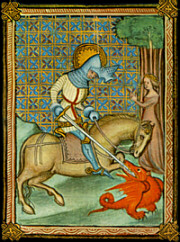 is a wonderful thing. Drawn to the tantalizing world of historical techniques as expressed through the fechtbuchen (fighting books), reenactors, martial artists, tournament society members and historical fencers have begun to communicate, creating a rich new renaissance of learning with respect to the practice of medieval fighting. Why all the interest in fighting techniques that were rendered technologically obsolete more than five centuries ago?
is a wonderful thing. Drawn to the tantalizing world of historical techniques as expressed through the fechtbuchen (fighting books), reenactors, martial artists, tournament society members and historical fencers have begun to communicate, creating a rich new renaissance of learning with respect to the practice of medieval fighting. Why all the interest in fighting techniques that were rendered technologically obsolete more than five centuries ago?
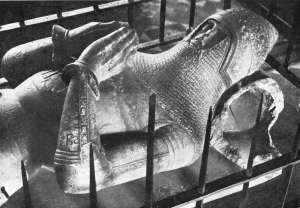 You
only one which can be associated with an individual of more than local fame. Born probably between c.1315 and c.1320,
the eldest son of David Calveley of Lea, Cheshire, and Joanna his wife, Sir Hugh Calveley was one of the most famous of
the many distinguished soldiers produced by the Hundred Years War. A leader of free companies, the greater part of his
life was passed in warfare, and his name occurs frequently in contemporary accounts of the campaigns carried on in
France, Gascony, Brittany, Flanders and Spain during the second half of the fourteenth century.
You
only one which can be associated with an individual of more than local fame. Born probably between c.1315 and c.1320,
the eldest son of David Calveley of Lea, Cheshire, and Joanna his wife, Sir Hugh Calveley was one of the most famous of
the many distinguished soldiers produced by the Hundred Years War. A leader of free companies, the greater part of his
life was passed in warfare, and his name occurs frequently in contemporary accounts of the campaigns carried on in
France, Gascony, Brittany, Flanders and Spain during the second half of the fourteenth century.
 You face your opponent en guarde, waiting for his move. He lunges at the left side of your chest. Without thinking you parry the thrust across
your body and then extend your sword in a counterthrust, aiming at the center of your opponent's chest. A perfect parry-riposte in quarte,
simple, the first defensive maneuver we are taught in modern sport-fencing. Except that this riposte doesn't land. Your opponent has simply
recovered from his lunge and your counterthrust has fallen short.
You face your opponent en guarde, waiting for his move. He lunges at the left side of your chest. Without thinking you parry the thrust across
your body and then extend your sword in a counterthrust, aiming at the center of your opponent's chest. A perfect parry-riposte in quarte,
simple, the first defensive maneuver we are taught in modern sport-fencing. Except that this riposte doesn't land. Your opponent has simply
recovered from his lunge and your counterthrust has fallen short.
 a mountainous island chain off the coast of Morocco. It features a wide variety of Estilos (styles), which are usually named after the families which have preserved and perpetuated specific teaching systems, and also many distinct juegos (games) featuring different rules, strategies and techniques.
a mountainous island chain off the coast of Morocco. It features a wide variety of Estilos (styles), which are usually named after the families which have preserved and perpetuated specific teaching systems, and also many distinct juegos (games) featuring different rules, strategies and techniques.
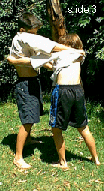 seen on TV where entertainment rather than competitiveness is the aim. Similar to Judo, and unlike most other Celtic styles, a jacket is used which enables opponents to gain a hold of each other. An important feature of this style, apart from the short canvass jacket, is that there is no groundwork (wrestling whilst on the ground) whatsoever.
seen on TV where entertainment rather than competitiveness is the aim. Similar to Judo, and unlike most other Celtic styles, a jacket is used which enables opponents to gain a hold of each other. An important feature of this style, apart from the short canvass jacket, is that there is no groundwork (wrestling whilst on the ground) whatsoever.
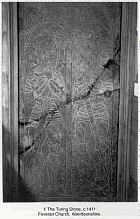 His article begins with
His article begins with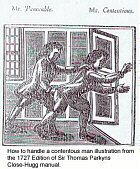 The same can be said for Asian martial traditions as well. The indigenous wrestling of England's West Country and of the Cornish people themselves has a history that extends before Medieval times and possibly back into ancient times as well.
The same can be said for Asian martial traditions as well. The indigenous wrestling of England's West Country and of the Cornish people themselves has a history that extends before Medieval times and possibly back into ancient times as well.
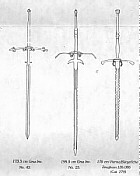 However, Mr. Melville has uncovered various evidence that aptly describes this weapon of destruction. This article illustrates the possible sources for the development of the two-handed sword, as well as revealing evidence of its usage as early as the crusades in 1096. It has been frequently assumed that the two-hander originated in Switzerland, however, as the article reveals, Switzerland had no iron ore or iron industry in the early Middle Ages and therefore, the Swiss had to import (or win as booty) arms and armour.
However, Mr. Melville has uncovered various evidence that aptly describes this weapon of destruction. This article illustrates the possible sources for the development of the two-handed sword, as well as revealing evidence of its usage as early as the crusades in 1096. It has been frequently assumed that the two-hander originated in Switzerland, however, as the article reveals, Switzerland had no iron ore or iron industry in the early Middle Ages and therefore, the Swiss had to import (or win as booty) arms and armour.
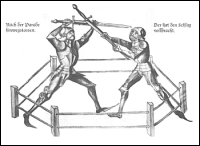 These include "live-fantasy" boffer fighters, for whom "Medieval combat" is simply a facet of the bigger game, the martial sport of many American derived medieval "recreation" societies, the "battle pageants" many living history groups perform for the public, and the pure martial focus of organizations such as the Academy of European Medieval Martial Arts or the Historical Armed Combat Association.
These include "live-fantasy" boffer fighters, for whom "Medieval combat" is simply a facet of the bigger game, the martial sport of many American derived medieval "recreation" societies, the "battle pageants" many living history groups perform for the public, and the pure martial focus of organizations such as the Academy of European Medieval Martial Arts or the Historical Armed Combat Association. 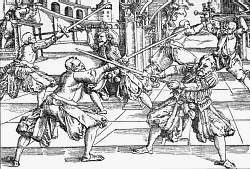 The government by a feudal hierarchy based on military service, the domination of the battlefield by an elite warrior class with a strict code of conduct, the cultivation of arts and letters alongside the use of weapons-all of these subjects have been noted and discussed at length. Less attention, however, has been paid to the close parallels between the fighting arts of the European knight and the samurai of feudal Japan.
The government by a feudal hierarchy based on military service, the domination of the battlefield by an elite warrior class with a strict code of conduct, the cultivation of arts and letters alongside the use of weapons-all of these subjects have been noted and discussed at length. Less attention, however, has been paid to the close parallels between the fighting arts of the European knight and the samurai of feudal Japan.
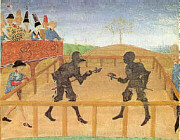 In time, Jacques became so
famous that contemporary authors wrote two separate accounts of his life. This article is primarily based on Georges Chastellain's work, Le Livre Des
Faits De Jacques Lalaing (The Book of the Deeds of Jacques de Lalaing). A member of a prominent family in the county of Hainault, today split
between southern Belgium and northern France, Jacques' ancestral home was in Douai, just inside the French border.
In time, Jacques became so
famous that contemporary authors wrote two separate accounts of his life. This article is primarily based on Georges Chastellain's work, Le Livre Des
Faits De Jacques Lalaing (The Book of the Deeds of Jacques de Lalaing). A member of a prominent family in the county of Hainault, today split
between southern Belgium and northern France, Jacques' ancestral home was in Douai, just inside the French border.
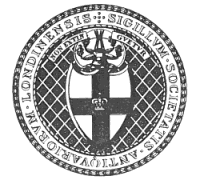 According to Dr. Anglo, there exists only one known treatise devoted exclusively to the technique of axe combat - Le Jeu de la Hache (Bibliotheque Nationale, Manuscrit francais 1996), a fifteenth-century treatise on the technique of chivalric axe combat and that is now published for the first time in this article.
According to Dr. Anglo, there exists only one known treatise devoted exclusively to the technique of axe combat - Le Jeu de la Hache (Bibliotheque Nationale, Manuscrit francais 1996), a fifteenth-century treatise on the technique of chivalric axe combat and that is now published for the first time in this article.
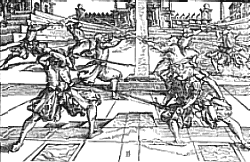 As with most aspects affecting human endeavor these two areas interact in their influence on the system development, and on each other. The distinctions between endogenous and exogenous factors might appear somewhat blurred, but are relatively clear in isolation.
As with most aspects affecting human endeavor these two areas interact in their influence on the system development, and on each other. The distinctions between endogenous and exogenous factors might appear somewhat blurred, but are relatively clear in isolation.
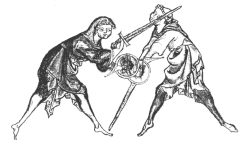 in
question, Royal Armouries manuscript I.33, is unassuming from the outside,
being a slim codex of 32 leaves in an uninsipired binding of the 18th or
19th century. Inside, over a hundred ink-and-watercolour drawings, with
extensive Latin commentary; the text is a Fechtbuch, a combat manual,
describing a technique of fighting with sword and buckler.
in
question, Royal Armouries manuscript I.33, is unassuming from the outside,
being a slim codex of 32 leaves in an uninsipired binding of the 18th or
19th century. Inside, over a hundred ink-and-watercolour drawings, with
extensive Latin commentary; the text is a Fechtbuch, a combat manual,
describing a technique of fighting with sword and buckler.
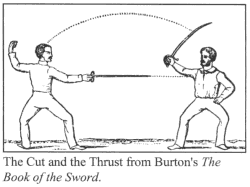 Pre-arranged Movement/Behaviour Patterns or PMBP. It is considered that
PMBPs are the behavioural constructs employed in combat situations, which
range from relatively simple combinations of primary movement patterns
(those movements that are instinctually based) to highly complex arrangements
of secondary movement patterns (learned behaviour/movements) that require
literally thousands of repititions in practice to gain a functional level
of skill for performance in a non-stress situation.
Pre-arranged Movement/Behaviour Patterns or PMBP. It is considered that
PMBPs are the behavioural constructs employed in combat situations, which
range from relatively simple combinations of primary movement patterns
(those movements that are instinctually based) to highly complex arrangements
of secondary movement patterns (learned behaviour/movements) that require
literally thousands of repititions in practice to gain a functional level
of skill for performance in a non-stress situation.